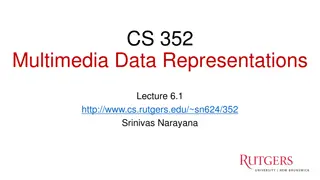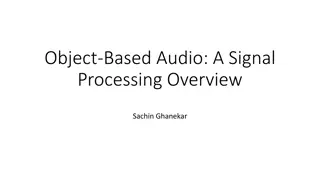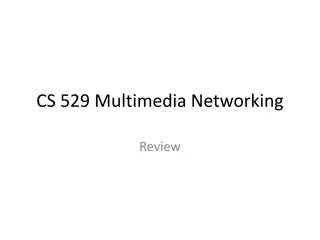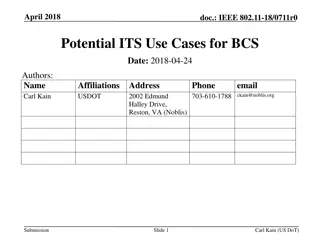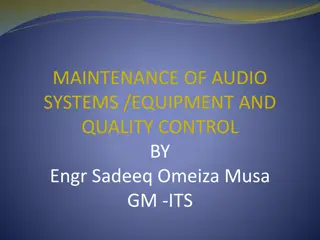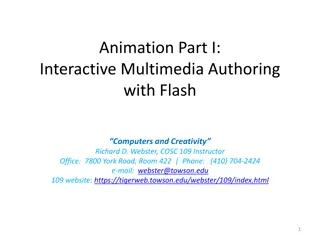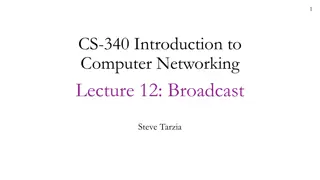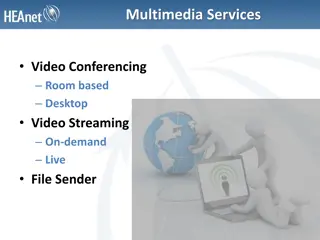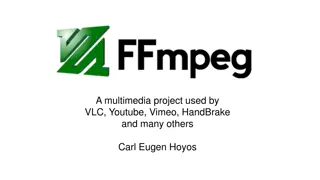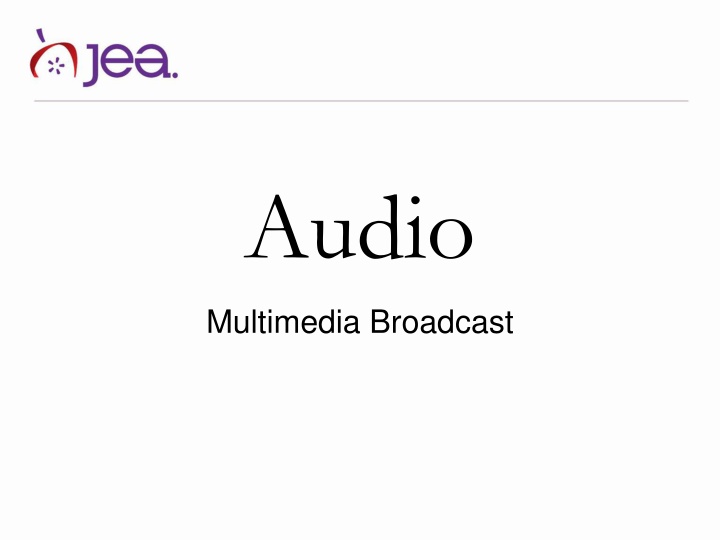
Audio Terms and Microphone Types for Broadcast and Multimedia
Explore the key concepts of audio such as analog and digital sound waves, pickup patterns, ambient audio, and microphone types & placement. Enhance your knowledge of audio terminology and practices in broadcasting and multimedia production.
Download Presentation

Please find below an Image/Link to download the presentation.
The content on the website is provided AS IS for your information and personal use only. It may not be sold, licensed, or shared on other websites without obtaining consent from the author. If you encounter any issues during the download, it is possible that the publisher has removed the file from their server.
You are allowed to download the files provided on this website for personal or commercial use, subject to the condition that they are used lawfully. All files are the property of their respective owners.
The content on the website is provided AS IS for your information and personal use only. It may not be sold, licensed, or shared on other websites without obtaining consent from the author.
E N D
Presentation Transcript
Audio Multimedia Broadcast
Audio Terms Analog Audio Sound Waves that are recorded directly onto a medium such as a tape. Digital Audio Sound Waves are sampled and stored a computer or other device. Channels Audio is usually separated into separate channels. For Multimedia and Broadcast, usually audio is restricted to a left and right channel if the device is in Stereo. If the device is in mono, then you will only have one channel Mono Audio singles are mixed together to create one source Stereo Signals are separated into left and right channels
Audio Terms Audio Pickup Patterns Omnidirectional Omni or all, sound is picked up from all directions Unidirectional Uni or one, sound comes from the one direction it is pointed at Bidirectional Bi or two, sound comes from two different or opposite directions Cardioid Or heart shaped, sound is very close to unidirectional with some pickup to the sides. Usually most hand-held microphones have this pattern
Pickup Pattern Practice Create a sketch of what you think a pickup pattern would look like on a paper for each of the following microphones Omnidirectional Unidirectional Bidirectional Cardioid Compare your sketch with a partner.
Audio Terms Ambient Audio The sound that exists in the room without creating any additional sounds. Sound Effects Artificial sounds that did not exist in the original recording Music Used to create dramatic moods or fill voids in sound
Lavaliere Microphone Typically used in situations that allow for the talent to sit down and be interviewed These microphones can be both wired and wireless. If they are wireless, they normally have to have programmed to specific frequencies Wireless systems have a transmitter pack with a wired microphone and a receiver with 1 or 2 antennas
Lavaliere Microphone Placement Place the corded part of the transmitter on the outside of your talent s shirt by using a microphone clip Try to avoid placing the clip so that is causes the microphone to rub against the talent s shirt. Also, ask your talent to run the corded portion under his/her shirt so it looks more professionally done
Boom Microphone Also called a Shotgun Microphone A directional microphone that typically is used in situations where your subject will be moving or if there are more subjects than you have microphones.
Boom Microphone Placement On top of a small camera or a DSLR photography camera Typically these use a jack. Some will still use a XLR cord Mount a shotgun microphone onto a boom pole that needs to be pointed at the person speaking.
Hand-Held Microphone Sometimes called a stick or hand mic Many have an off/on switch Can be wired or wireless If wireless, the microphone will be attached to a transmitter that sends a signal to a receiver attached to your camera
Hand-Held Microphone Placement The best way to measure where you place a hand-held microphone is to use your fist. Place your fist against the bottom of your chin, then place the microphone against the bottom of your fist. Try to estimate the same distance if you are interviewing someone while using it Don t forget to point it at their mouth when they are talking
Common Audio Accessories XLR Cables RCA Cables 1/4 cable 1/4 to XLR Adapter Sound Mixer
Microphone Practice In small groups, do a field test for each of the microphones that you have in your class. Try testing each of the microphones in different settings Inside a small room with and without other people Inside a large room with and without other people Outside near people and away from people
What to look for There are a variety of audio editing software packages available for free and for a cost. When choosing, consider these features: The ability to record audio through a port on your computer The ability to trim the beginning, middle and end of your recording The ability to change the volume of tracks The ability to mix multiple sources into a master track The ability to apply filters or effects to alter original tracks The ability to save the finished edit in various formats
Audio Editor Single-Track of Audio Multi-Track Editing
Audio in Journalism Projects Conduct an audio interview Create an audio feature completely of others words Create an audio talk show or podcast Create an complete audio story
Advanced Audio Moving beyond basic knowledge
Advanced Audio How do we hear sounds and why do they sound different? Frequency Amplitude
Advanced Audio Frequency Sound travels through air It changes from changes in air pressure It travels as sound waves When sound waves hit your ear drum, they become sound
Advanced Audio Amplitude Easiest to think of as the loudness of the sound The higher it is, the more air it pushes around Measured in decibels
Advanced Audio Frequency & Amplitude You now have your pitch and loudness
Advanced Audio Human Hearing Low 20Hz High 20kHz Advanced Audio Hands On Using your audio editor, record a simple voice over and experiment with raising or lowering the volume at different levels of amplitude or db (decibels) Watch the Audio Hands on Example for short tips




